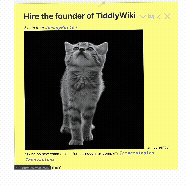I abstracted this into a reusable component that lets you chose one tiddler for this behavior. When that tiddler is in the story river, it looks like a large pinned sticky note. When it gets closed, a smaller pinned sticky note appears in the sidebar, containing just its title. When that’s clicked, the tiddler is launched back into the story river.
With Jeremy’s blessing, I’m sharing it here.
Testing
Special handling for main site
If you want to test it on tiddlywiki.com and Jeremy’s version is running, you’ll need to first delete two tiddler that would conflict:
Everywhere
Then download the following, drag it to your wiki, and choose to Import:
pincard.json (992.9 KB)
You should see the demo sticky card in the sidebar. That’s just throwaway for demo purposes. But if you click on it, the sidebar segment will collapse, as @etardiff described, and the main tiddler will open in the story river. And closing that, the sidebar segment will expand again.
Configuring
To choose your own tiddler for display, edit the tiddler $:/_/pincard/config/title and set the text to the name of your tiddler. That’s it. That’s the only configuration for this version. It’s easy to imagine much more.
The code
Besides the Demo tiddler, this consists of
-
$:/_/pincard/config/title. This was mentioned above’ it’s used to decide which (single) tiddler gets this treatment.
-
$:/_/pincard/content/sidebar-segment. This is the renamed version of Hire Jeremy Sidebar Segment, and has the same behavior Emily described above. The only changes were to remove the hard-coded link to the appropriate tiddler and use a dynamic reference, based on $:/_/pincard/config/title, and to replace the hard-coded text with that title.
-
$:/_/pincard/screenshot. This is in there just to give the Demo Tiddler something hefty. Then I changed my mind and buried it under a <details> element. It’s not important to the functioning of this tool, and I’ll remove it if I continue to build this out.

-
$:/_/pincard/styles. This is where the bulk of the work is happening, and Emily described it well above. There is a tiddler title, whose name is checked in the the wikitext conditions determining which parts of the CSS are active. My only change was to make that tiddler name dynamic, using the value from $:/_/pincard/config/title.
-
$:/_/pincard/tempates/top-pin. In the original version, the markup that was used for the little pin itself was in the tiddler we’re displaying. But that makes no sense in a more general setting. So here, instead, we put it in a standalone ViewTemplate to appear above the body. It is guarded by a check of whether we are the in tiddler indicated by $:/_/pincard/config/title. If we were to redo Jeremy’s initial version, we would need only remove that (now unnecessary) line from the top of the sidebar, and restore some CSS I removed that was specific to his tiddler.
Bug
There is one bug that I don’t know how to squash. In Jeremy’s version, the tiddler in the story river has a small animation on hover: the card loses its small tilt and grows slightly. This one doesn’t have the smooth animation, but just jumps. The transition styles are all there, but it seems as though the classic storyview after performing its animation into the story river, sets the tiddler view’s style to include transition: none. Because this is an element style, it’s overriding the value in the stylesheet. I haven’t been able to determine how Jeremy overcame it. (Any hints, @jeremyruston?)
Tutorial
Jeremy suggested that it might be worthwhile to write a tutorial showing how this works, to be included in the main site. I’ve long been a proponent of adding Tutorial and Explanation documentation to complement the Reference and How-to documentation that already exists. (See https://diataxis.fr/ for more about that breakdown.) So I’ve agreed to look into doing so. That’s a much longer-term project, though, as we don’t really have any tutorial examples to start from.
Note
This UI is quite intrusive, intentionally so. While I might well finish this up, and create a simple plugin out of it, I would suggest that its usage should be extremely rare.

